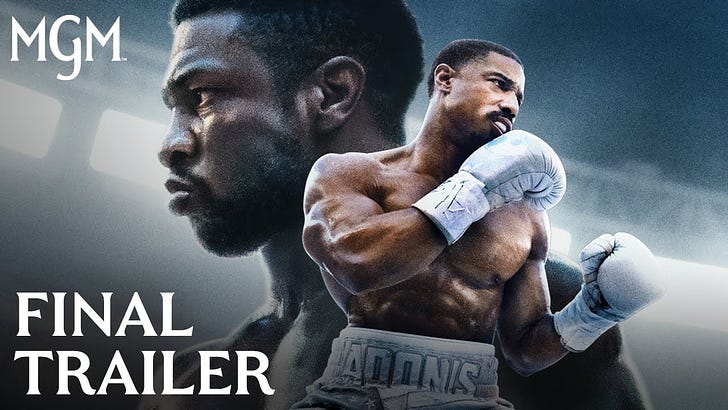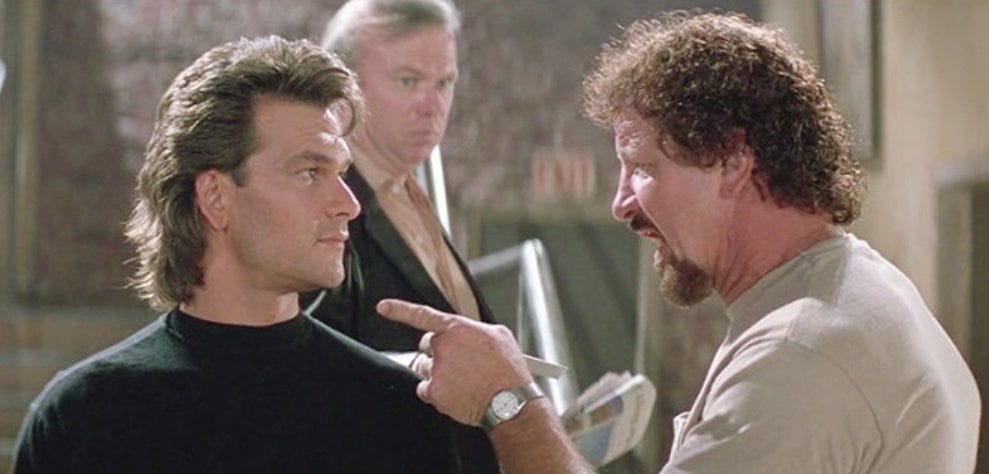Sports Movie Monday: Paradise Alley (1978)
Sylvester Stallone's novel-turned-screenplay, written before Rocky and released after, takes on professional wrestling in post-World War II New York.
“Wrestling can be your passport out of this city. It’s a growing sport, I’m telling you.”
So says Cosmo Carboni, Sylvester Stallone’s lead character in the 1978 film Paradise Alley, to his brother Victor Carboni. And indeed, as a film set in New York during the post-World War II 1940s, Sly’s fast-talking character proves prescient. Professional wrestling, in the form we know it today—existing less as athletic competition and more as sports-based theater—experienced a nationwide boom in popularity shortly after the war, thanks to the advent of television.
Wrestling existed for decades prior, with different promoters cultivating engaged audiences throughout North America. A World Championship bout between Lou Thesz and football star Bronko Nagurski, for example, sold out the Sam Houston Coliseum in Texas in the 1930s.
Likewise, reports of wrestling cards filling opera houses date back to the late 19th century. But the common perception of pre-television wrestling is that shows were staged primarily for the readymade crowds attracted to traveling carnivals—and there is certainly validity to that.
In fact, a familiar pejorative still applied to wrestling today—carny—stems from the medium’s early ties to carnivals.
Television wasn’t the opening salvo in bringing wrestling out of circus tents and to the masses, though. Rather, wrestling provided TV with an easily filmed event that brought in an existing audience, while local wrestling promoters gained another—and their most powerful—vehicle yet for attracting new customers.
Part of appealing to a new audience meant more elaborate presentations with the introduction of more colorful characters. The portion of Paradise Alley dedicated to wrestling touches on this, but never explicitly, nor as a particularly important part of the story.
Really, wrestling is secondary to Paradise Alley’s overarching themes of brotherhood and delusions of grandeur turned into success.
Production
Released after the smash success of Rocky, Stallone’s writing/starring follow-up and directorial debut fizzled commercially and critically. Paradise Alley may have been a victim of misconception, however—beginning with the description of it as a follow-up to Rocky.
While Paradise Alley came to the screen two years after Stallone’s surprise Academy Award-winning and franchise-launching boxing epic, Sly wrote Paradise Alley before writing Rocky. In fact, Rocky was born of Paradise Alley sitting in production purgatory, when producers who had purchased the latter—initially written by Stallone as a novel, then adapted into a screenplay—sat on the script.
With Rocky producer Robert Chartoff initially interested in financing Paradise Alley, but Stallone unable to reacquire the rights, Stallone punched out his screenplay for Rocky.
It’s quite a paradox that Rocky only existed because of Paradise Alley, yet Paradise Alley was only made because of Rocky. On the flip side, perhaps Paradise Alley might have been better received had it not drawn immediate—and not entirely accurate—comparisons to its cinematic predecessor.
Plot
Familiar themes shape both stories. Stallone’s main protagonist takes pride in his Italian heritage, comes from a lower economic class in a major Eastern city, and has big dreams ultimately realized within a ring. Love interests also drive some of the narrative in both films.
In Paradise Alley, relationships mold the film’s first half and are multilayered: Stallone’s Cosmo Carboni pines for Annie, the ex of his brother Lenny. Annie is played by Annette Archer.
Cosmo’s other love interest, Bunch—played by Joyce Ingalls—has a limited role but is endearing as a prostitute eager to leave that life and build a home with Cosmo.
But whereas Rocky is unambiguously a boxing movie from bell to bell, Paradise Alley doesn’t even introduce professional wrestling until more than 40 minutes into its 108-minute runtime.
Well, at least professional wrestling isn’t part of the main plot until that point. Wrestling’s presence is established just minutes in when the late, great grappler Terry Funk appears on screen.
Funk plays Frankie The Thumper, the muscle for low-level Irish-American hustler Stitch Mahon.
Stitch and his crew represent the dark side of 1940s Hell’s Kitchen, where the Carboni brothers—Cosmo, Victor, and Lenny—reside. While today we know post-World War II America as a place of tremendous prosperity, Paradise Alley’s Hell’s Kitchen feels trapped in the Great Depression.
Extreme poverty and the desperation that comes with it are rampant, providing each of the film’s characters with their foundation and motivation. Cosmo chases cash through a variety of schemes, teetering on the line between an honest life and falling into the criminal element like Stitch’s crew.
He has big dreams, but no real goal. Lenny—played by Armand Assante—had his dreams and goals shattered, literally, with the loss of a leg fighting in World War II. Lenny has the most natural potential of the Carboni brothers but has lost the drive to fulfill it.
Vic, the youngest of the Carbonis, is played by former professional boxer Lee Canalito. I don’t know if Stallone took inspiration from John Steinbeck’s Of Mice and Men, with one of the brothers being named Lenny hinting at a possible homage, but Vic has undeniable qualities reminiscent of the Steinbeck novel’s Lennie character.
He’s a slow-witted, gentle giant with a violent streak that can be coaxed out of him—which it is, thanks to Cosmo seeing Vic’s strength as a money-making prospect once the brothers discover wrestling shows staged at the film’s titular club.
While Vic is portrayed as simple-minded and childlike, he’s the only Carboni with a clear goal: to save enough money to buy a houseboat and live on the Jersey Shore with his tutor and girlfriend, the daughter of Chinese migrants named Susan.
So when Cosmo sees wrestling at the Paradise Alley club as an opportunity to cash in, Vic is no unwitting participant. But he is exploited along the way once Lenny finds his lost motivation working as Vic’s promoter, pushing him into a grueling schedule.
Vic spends the film’s latter half wrestling as the unbeatable “Kid Salami,” a gimmick created by Cosmo. Vic endures tremendous physical abuse in the ring and emotional abuse from Lenny. The dynamic forces Cosmo to become more grounded, with the reality of using people for personal gain hitting him hardest when downtrodden wrestler Big Glory commits suicide by jumping into the Hudson River after a night of alcohol-fueled fun with Cosmo.
Cosmo, Lenny, and Vic reach a crescendo in their respective arcs in a climactic final wrestling bout between Kid Salami and Frankie The Thumper.
Cast
Coming off Rocky, seeing Sylvester Stallone as anything but the Italian Stallion might have been difficult. To that end, I understand some of the criticisms at the time of Paradise Alley’s release drawing the parallel.
However, Cosmo Carboni is much less Rocky Balboa than he is a combination of Paulie and Mickey. Cosmo is a natural carny and, for two-thirds of the film, supremely self-absorbed—but with a certain charm.
Stallone’s acting zenith runs from Rocky through Rocky III. In the latter half of the 1980s, he fell into a trap similar to what has been commonly rumored of Dwayne Johnson in recent years with an unwillingness to portray characters with any real flaws.
But whereas roles like in Cobra, Tango & Cash and the Rambo sequels depicted Stallone’s characters as unflappable and infallible, his first foray as John Rambo and initial appearances as Rocky Balboa are gritty, realistic and relatable. Cosmo Carboni falls into the latter group.
Meanwhile, Terry Funk gained billing as a second lead in more recent years since Paradise Alley gained some traction in the wrestling podcasting world. That’s a vast overstatement of Frankie The Thumper’s significance to the plot, but Funk is indeed terrific in his limited part.
Sure, the Funker might be drawing primarily from his own 1970s wrestling heel shtick. But if transitioning a wrestling persona to the big screen was easy, Hulk Hogan and Triple H would have had more success in Hollywood through vehicles like No Holds Barred and Blade: Trinity.
Funk never became a star of the cinema, but his intensity in Paradise Alley could have translated effectively to bigger roles. If nothing else, at least this opened the gateway for his appearance in one of my all-time favorite movies, Road House.
Armand Assante enjoyed a lengthy career as a character actor, including in one of my favorite films of the last 20 years, American Gangster. He’s the most polished of the Carboni brothers, even if Stallone had reached bankable star status by 1978. However, Lee Canalito’s performance as Victor is the most surprising when viewing Paradise Alley decades after its release.
Canalito is terrific as the soft-spoken Vic in what was his only major acting role. His film career mirrors his boxing career in that regard; based on my research for this newsletter, Canalito showed great promise in the ring, but never advanced beyond a certain threshold to become a known name in the sweet science.
Likewise, his tenure on screen peaked with Paradise Alley. Canalito remained close with Stallone—to the point that Sly’s fledgling boxing promotion, Tiger Eye Limited, managed Canalito’s career. To that end, I’m surprised Canalito never played a role in the Rocky franchise.
Fellow athlete-actor Frank McRae, who played Paradise Alley wrestler Big Glory, had a far longer and more distinguished film career. A star lineman at Tennessee State in the 1960s, McRae played for the Chicago Bears before embarking on acting.
McRae appeared in Red Dawn, National Lampoon’s Vacation, Last Action Hero, and—in this newsletter’s second reference to John Steinbeck—the 1982 film adaptation of Cannery Row.
McRae spent his cinematic tenure primarily as a bit player, which is a shame. As Paradise Alley’s Big Glory, he portrays the struggling, aging wrestler with a painful stoicism I found captivating. Some of his dialogue can be cringe-inducing when viewed through a 21st-century lens, but McRae’s performance overcomes that.
In an alternate universe, a film focused on Big Glory and Kid Salami as in-ring rivals but behind-the-scenes friends, touring the country wrestling each other from territory to territory, could have been incredible.
And so could Paradise Alley, if not for the limitations it faced.
Review
Growing up a longtime fan of wrestling, I couldn’t believe that a film focused on the sport of kings, starring an A-list actor in Sylvester Stallone and distributed by a major studio like Universal, was not on my radar until I was in my 30s.
Paradise Alley’s mostly poor reception in 1978 and limited availability on the home video market during the early 2000s DVD boom relegated the movie to obscurity. It never gained a cult following, from what I can tell—presumably for the same reasons that it drew unfavorable reviews upon release.
Stallone lamented in later interviews that he wishes he had been more assertive in some of the creative choices, most notably in shortening the film. Knowing this going into a watch of Paradise Alley, it’s easy to understand Stallone’s frustration.
The film feels like it’s missing major beats. Significant character development happens abruptly, and storylines—like Vic’s houseboat dream—do not receive clear resolution.
Annie’s on-again, off-again relationship with Lenny likewise falters as soon as it rekindles on-screen, and Bunch’s love affair with Cosmo disappears with about an hour left in the story.
To that end, Paradise Alley feels like two very different movies stitched together—each with potential on its own that falls short when mashed into one.






